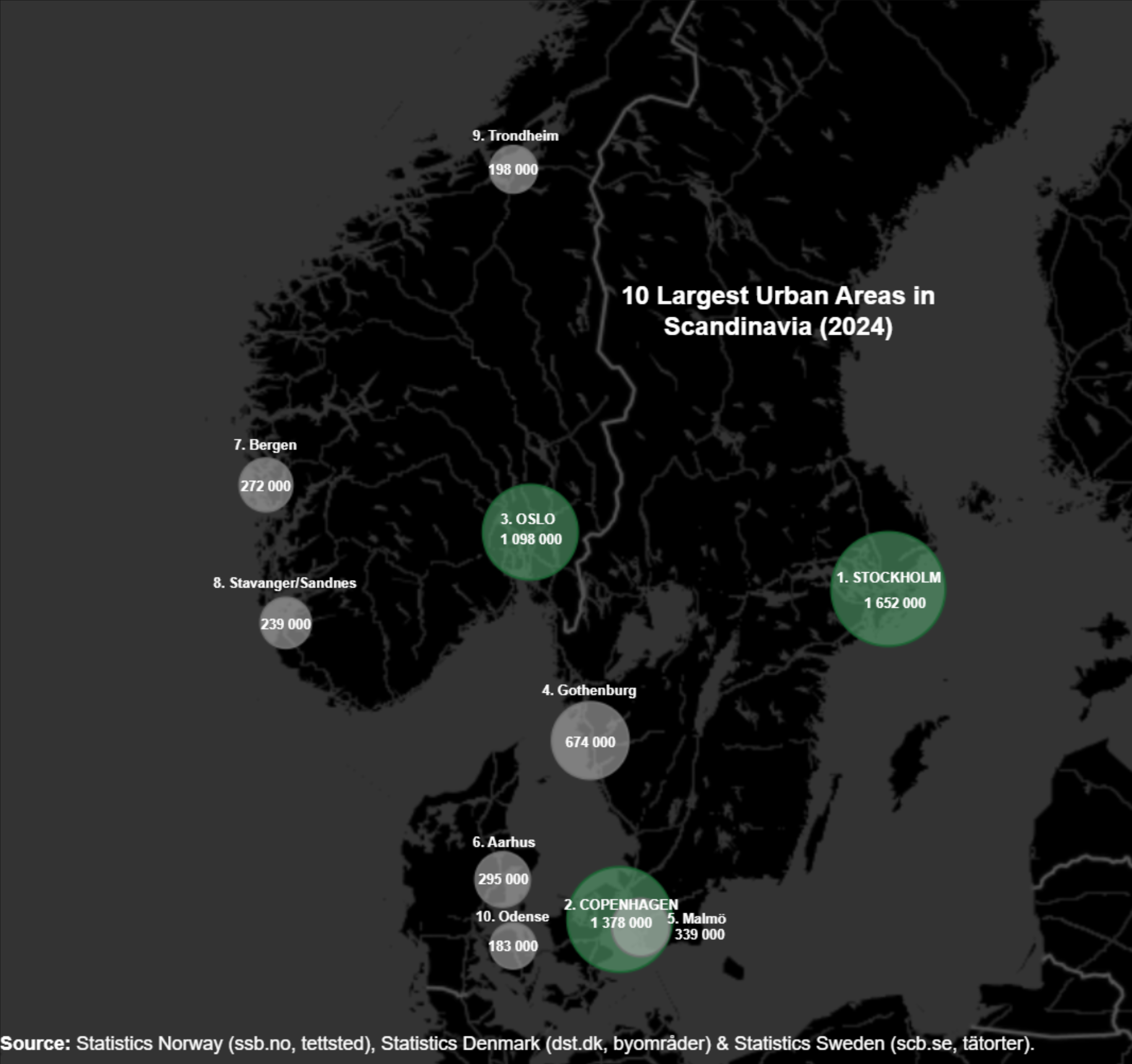Largest Cities in Scandinavia Map


David Chen
Data Visualization Specialist
David Chen is an expert in transforming complex geographic datasets into compelling visual narratives. He combines his background in computer science ...
Geographic Analysis
What This Map Shows\nThis map visualizes the ten largest cities and urban areas in Scandinavia for the year 2024. It highlights key population centers in this culturally rich and geographically diverse region, presenting a clear picture of urbanization trends across Norway, Sweden, and Denmark. These cities are not only significant in terms of population but also play crucial roles in the economic and cultural landscape of Scandinavia.
Deep Dive into Urbanization in Scandinavia\nUrbanization is a defining feature of modern society, and in Scandinavia, it has led to some fascinating developments. The urban areas depicted in the map, including cities like Stockholm, Oslo, and Copenhagen, showcase a blend of historical significance and contemporary growth. Have you ever wondered why these cities have become so prominent?
Scandinavia has experienced a steady increase in urban population over the past few decades. For instance, Stockholm, the largest city in Sweden, boasts a population of over 1 million in its city proper and nearly 2.5 million in the metropolitan area. This growth can be attributed to various factors, including economic opportunities, high living standards, and a strong welfare system that attracts individuals from other regions and countries.
Copenhagen, Denmark's capital, is another urban area that has seen significant growth. With a population exceeding 1.3 million in its metropolitan area, it serves as a cultural and economic hub. Interestingly, Copenhagen has been recognized for its sustainability initiatives, which is a growing trend in urban areas worldwide. The city's commitment to cycling, green spaces, and renewable energy has made it an attractive destination for both residents and tourists.
Oslo, Norway’s capital, has also witnessed substantial urban development, now housing over 1.5 million people in its metropolitan area. The city is known for its stunning natural surroundings, which have influenced its urban planning. The integration of nature with urban life is a hallmark of Oslo's development strategy, making it a unique case among Scandinavian cities.
Other notable cities include Gothenburg and Malmö in Sweden, which serve as vital ports and economic centers. Gothenburg, located on the west coast, is Sweden's second-largest city, known for its maritime history and vibrant cultural scene. Meanwhile, Malmö, connected to Copenhagen via the Øresund Bridge, has transformed into a dynamic urban area with a diverse population and a thriving tech industry.
Regional Analysis\nBreaking down the cities highlighted in the map reveals distinct characteristics and growth patterns in different regions of Scandinavia. For example, Southern Sweden, encompassing Malmö and Gothenburg, tends to have a more pronounced industrial base, while Northern cities like Umeå are experiencing growth due to an influx of students and professionals attracted by universities and tech industries.
In Norway, the contrast between urban and rural areas is stark. Cities like Oslo and Bergen are rapidly expanding, while remote areas struggle with depopulation. This urban-rural divide raises important questions about resource allocation and development strategies in the broader context of Norway’s economy.
Denmark’s capital, Copenhagen, stands out due to its global connectivity and strong economic performance. The city has a lower unemployment rate compared to other Scandinavian cities, which contributes to its continued population growth. In contrast, cities further from the capital, like Aarhus and Odense, are developing but face challenges in retaining talent and resources.
Significance and Impact\nUnderstanding the dynamics of urbanization in Scandinavia is crucial for several reasons. Firstly, these cities significantly contribute to national GDPs and employment rates, shaping the economic futures of their respective countries. As urban areas expand, they also influence regional development policies and environmental strategies.
Moreover, the trends observed in these cities reflect broader global patterns of urbanization, sustainability, and demographic shifts. For instance, the increasing focus on sustainability in urban planning in cities like Copenhagen sets an example for others worldwide. As climate change continues to be a pressing issue, cities that prioritize green infrastructure and sustainable living will likely become models for future urban development.
Looking ahead, projections indicate that urban areas in Scandinavia will continue to grow, though this growth may vary significantly from city to city. As the population trends evolve, it will be essential for urban planners and policymakers to address challenges such as housing shortages, transportation infrastructure, and environmental sustainability to ensure that these cities remain livable and vibrant.
In summary, the map of the largest cities in Scandinavia for 2024 serves as a window into the region's urban landscape, revealing not just numbers but the stories of growth, challenges, and the future of urban living in this unique part of the world.
Visualization Details
- Published
- August 14, 2025
- Views
- 294
Comments
Loading comments...